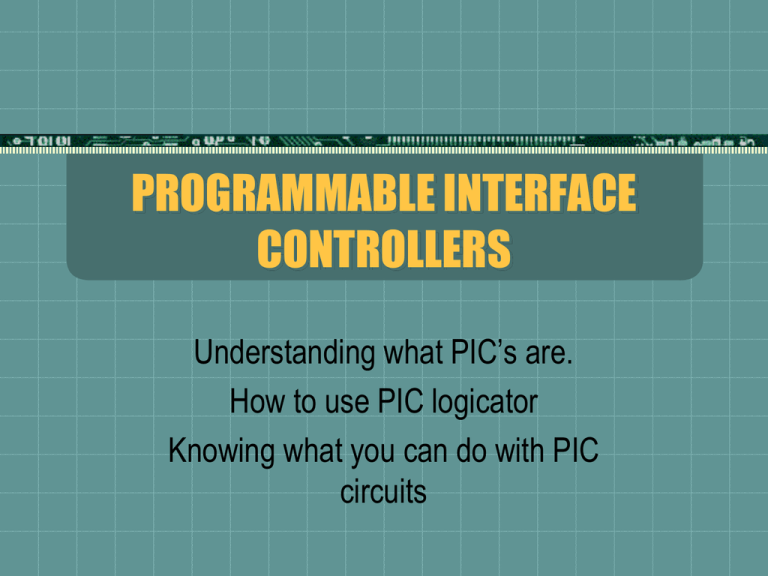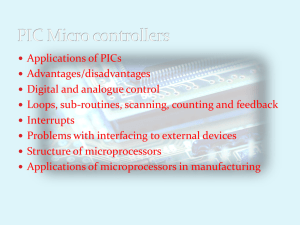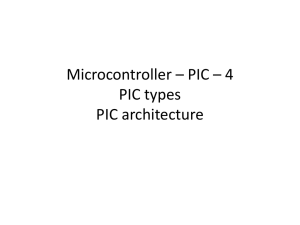PROGRAMMABLE INTERFACE CONTROLLERS
advertisement

PROGRAMMABLE INTERFACE CONTROLLERS Understanding what PIC’s are. How to use PIC logicator Knowing what you can do with PIC circuits What a PIC does PIC’s allow you to control output devices when they are triggered by sensors and switches. Programs can be generated by using flowcharts within computer software, which can then be downloaded into a PIC chip. They can be re-written as many times as you want. This type of memory is called flash memory. Inside the PIC CHIP A PIC microcontroller is a single integrated circuit small enough to fit in the palm of the hand and contains memory processing units, a Clock and Input/ Output circuitry in a single unit. A PIC microcontroller is ,therefore, often described as a computer in an integrated circuit. PIC microcontrollers can be purchased blank and then programmed with a specific control program. PIC microcontrollers can also be purchased with a pre-programmed set of commands that allows a direct cable download from a computer and reduces the cost of programming equipment. Advantages/Dis-advantages of PICs compared to a 555 Timer flashing circuit (astable) PIC allows greater control. Pattern can be tested on PC before build PIC can be programmed to produce different patterns Limited output from 555 Timer IC PIC requires fewer components PIC more costly than 555 PIC possibly smaller PCB PIC requires programming skills PIC TASK (EXAM QUESTION) Using a programming system you are familiar with, produce a sequence of commands, which would make a set of 4 LED’s, shown in Figure 3, switch on as shown below: Next to each of the commands, explain its purpose. All four LED’s go high for 1 second. A, B, C and D go high in sequence, each for 0.25 seconds. All four LED’s go high for 1 second. D, C, B and A go high in sequence, each for 0.25 seconds. This repeats continuously. Between each statement, all LED’s go low for 0.25 seconds. PIC TASK (EXAM QUESTION) Use a PIC to simplify the electronic circuit for a steady hand game The PIC system diagram is shown below; Use a PIC program to satisfy the following conditions. (a) Each time the wand and track touch, the PIC switches on an LED in the sequence 1, 2 and 3. Once an LED is lit it will stay on until reset. (9 marks) (b) Once the wand and track touch, the PIC will ignore any further contact between the wand and track for 2 seconds. (4 marks) (c) On the loss of the third life, the buzzer will switch on for 0.25s and then switch off for 0.25s. This is repeated three times. (6 marks) (d) The PIC program will re-set back to ‘no lives lost’. (3 marks) PIC TASK (EXAM QUESTION) The picture opposite shows a drawing of a lift with its doors open at the ground floor. The lift will only operate when a person has requested the lift from another floor, or a floor has been chosen by a person in the lift and the doorway is not obstructed. Design a flow chart to illustrate the lift operating sequence, from when the lift starts at the ground floor, with its’ doors open and is called to the first floor where its doors open. (10 marks) Quality of drawing (2 marks)





